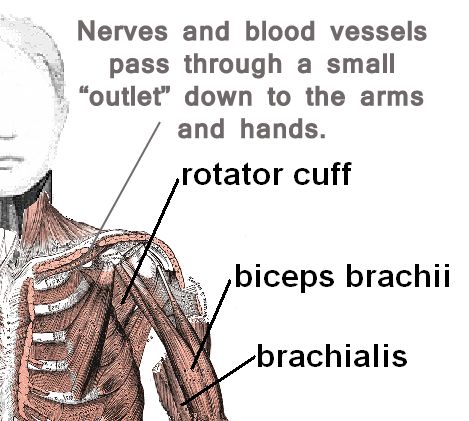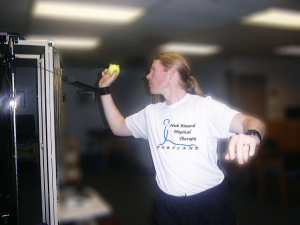By Megan Plante, DPT
22 May, 2014
Clinical Case of the Week
cervical, clavicle, clinical presentation, complicated, peck minor, Ribs, scalenes, Thoracic outlet syndrome, TOS
Recently, I have had 3 physical therapy patients in the clinic with a complicated clinical presentation. All 3 patients have a different cluster of symptoms and impairments. What they each have in common is that they have upper extremity symptoms that are not of cervical spine (radiculopathy) origin. Instead, their pathology is a result of tight chest and neck musculature, compressing the bundle of nerves that control the movement and sensation of the arm. Clinically, this is known as Thoracic Outlet Syndrome, or, TOS.
What is Thoracic Outlet Syndrome?
- Compression of the artery, vein and/or nerves that pass through the thoracic outlet.
- There are 3 possible locations for the compression to occur:
- In between your scalene (neck muscles)
- In between the clavicle and first rib
- Under the peck minor (chest muscle)
| The most common compression is of the nerves. This results in vague pain of the arm as well as various sensations: itchy, hot, cold, pins and needles, etc.It may be painful to the touch for any of the muscles involved with the compression.
Poor posture as well as decreased flexibility of the thoracic spine are also associated with TOS.
Rarely, an extra rib (cervical rib) is the cause. |
 |
Physical Therapy Treatment for TOS
- Physical therapy is the first line of treatment for Thoracic Outlet Syndrome (TOS).
- A therapist will teach you how to stretch what needs to be lengthened as well as how to strengthen muscles that will improve posture.
- Physical therapists also have manual techniques to help you progress your treatment
- Most people diagnosed with TOS have a good prognosis and will have complete resolution of symptoms with conservative treatment only.
More
By Nick Rinard MPT, Cert MDT
07 Mar, 2014
Clinical Case of the Week, Exercise, Physical Therapy Tips
abolished, cervical, MDT, neck pain, shoulder, sugery, true cause of pain
 Very interesting clinical presentation today! The patient had been treated for neck pain here (Nick Rinard Physical Therapy) in the past with good results. Later, she developed shoulder pain and consulted her MD, who referred her to an orthopedic surgeon. There were “findings” on MRI and she ended up getting arthroscopic surgery. She returned to us for physical therapy to rehabilitate after surgery.
Very interesting clinical presentation today! The patient had been treated for neck pain here (Nick Rinard Physical Therapy) in the past with good results. Later, she developed shoulder pain and consulted her MD, who referred her to an orthopedic surgeon. There were “findings” on MRI and she ended up getting arthroscopic surgery. She returned to us for physical therapy to rehabilitate after surgery.
No Surgery Needed
Interestingly, she reported that her surgeon was surprised that her rotator cuff tendons were in “good condition” and did not require a repair – he had noticed that during the surgery procedure itself, apparently. So, physical therapy should be easy in such cases, right? No big surgical repair to worry about.
However, 6 weeks after the operation, her shoulder pain was not subsiding as it should have. Inflammation normally resolves in that amount of time and she should have been strong enough to resume normal office work duties consisting of keyboard and filing.
Finding the True Cause of the Pain
We had to take a closer look at her neck. It turned out that her neck was referring pain to the shoulder! In one neck treatment, the shoulder pain was abolished! The patient probably had had a recurrence of her old neck problem, it referred pain to her shoulder, and neither she, her MD, nor the orthopedic surgeon considered the true cause of the pain…
This is a frequent occurrence here at Nick Rinard Physical Therapy, where we use the Mechanical Diagnosis and Therapy (MDT) system of evaluation and treatment. Robin McKenzie started this method and it is the best method – and most supported by research – at getting to the true cause of pain.
Save time, money, and maybe avoid surgery!
If you or someone you know is having any problems that could be mechanical, a thorough mechanical assessment should be performed. In as little as one visit the problem might be identified and solved, saving a lot of time, money, and suffering! Plus, the patient might avoid unnecessary surgery!
More


